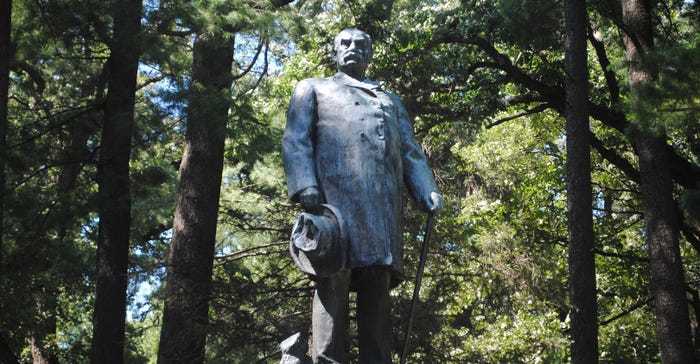
Nebraska is a diverse agricultural state, with a broad and interesting farming and ranching history. Some of the state’s finest ag history museums and educational sites help to tell the story of Nebraska agriculture through time.
In our series of Nebraska Farmer virtual tours, we encourage teachers, ag students, 4-H and FFA members, farmers and ranchers, and ag history enthusiasts to enjoy some of the state’s unique ag history sites through the camera lens of Nebraska Farmer editors.
Arbor Lodge State Historical Park
Julius Sterling Morton and his wife, Caroline or “Carrie,” moved to Bellevue in the Nebraska Territory not long after the land was opened to settlement in 1854. Born in New York on April 22, 1832, Morton grew up in Michigan and was educated at the University of Michigan.
In 1854, just after graduation, he married Carrie Joy French, his high school sweetheart. On their wedding day, they set out for Nebraska. Settling in the newly opened territory, the Mortons missed their beautiful orchards and became keenly aware of the differences between the eastern woodlands and the Plains.
That’s why the couple and their sons embarked on a lifelong mission to plant orchards and trees at their eventual new home, called Arbor Lodge at Nebraska City, and encouraged tree planting across the region. And that’s why Morton proposed the idea of an entire holiday dedicated to planting trees, Arbor Day, to the Nebraska State Board of Agriculture in 1872.
On that first Arbor Day in Nebraska, April 10, 1872, prizes were offered to the counties and individuals for properly planting the most trees on that day. It was estimated that more than 1 million trees were planted in the state on that first Arbor Day.
By 1874, another Nebraska tree enthusiast, Gov. Robert W. Furnas, issued the first proclamation designating Arbor Day, and in 1885, it became an official state holiday on Morton’s birthday. The unique holiday is now celebrated at different times in all 50 states and in several countries around the world. Arbor Lodge State Historical Park, Arbor Day Farms and the National Arbor Day Foundation are all now headquartered in Nebraska City.
Morton had a long and storied career as an agriculturist, tree planter and statesman. After the couple moved to Nebraska City, Morton became editor of the Nebraska City News, learning the trade from his grandfather’s newspaper office in Michigan.
From 1858-61, he was appointed as the territorial secretary of state, and was the acting territorial governor from 1858-59. During Morton’s time on the road working in the politics of the state, Carrie and their four sons became important caretakers to Arbor Lodge and the massive orchards, farm and woods surrounding the estate.
The March 1878 issue of Nebraska Farmer featured an engraving of the growing Morton estate. Carrie passed away tragically at age 47 in 1881 in her room at Arbor Lodge from complications of a leg infection.
As an ardent Democrat, Morton ran for Nebraska governor three times, but was unsuccessful. He was appointed U.S. secretary of agriculture in President Grover Cleveland’s cabinet from 1893-97, serving farmers across the country and helping to set up national forest preserves.
Morton was known as a frugal manager of USDA and as a respected civil servant, looking for ways to cut costs and save taxpayer dollars. After returning to his beloved Nebraska City, he started a newspaper called “The Conservative,” and he wrote a history of Nebraska. But he is most known as the author of the concept of Arbor Day. Morton died at the home of his son on April 27, 1902, in Lake Forest, Ill.
Today, if you visit Nebraska City, it is difficult to miss Morton’s continued presence and influence. But nowhere is that influence more present than at his beloved home, Arbor Lodge and his 72-acre estate. Now a state historical park, the Morton Mansion and surrounding grounds offer visitors an immersed experience at “ground zero” of Arbor Day.
The estate began as a four-room cabin but grew over time to a 52-room mansion. After Morton died, another addition was added by J. Sterling’s son Joy, who was the founder of the Morton Salt Co. and used the mansion as a summer home. Joy added the signature porticos, stucco exterior and the terraced Italian garden.
The furnishings displayed in the mansion today are Victorian and Empire style, with hand-carved woodwork throughout the house. Inside the beautiful, ornate mansion, visitors find hundreds of Morton family artifacts, and the study where Morton did most of his writing.
In 1905, Morton’s former boss, Cleveland, spent the night at the mansion during a visit for a memorial dedication honoring J. Sterling. It also is possible that Theodore Roosevelt visited the mansion, because Morton’s second-born son, Paul, was Roosevelt’s secretary of the navy. In 1923, Joy donated the house and the surrounding estate to the state of Nebraska, and it became the state’s second state park later that same year.
This Nebraska Farmer virtual tour offers a close-up view of Morton’s Arbor Lodge and the surrounding grounds where it all started, through the lens of our cameras.
Learn more about Morton and Arbor Lodge at outdoornebraska.gov/arborlodge.
About the Author(s)
You May Also Like






